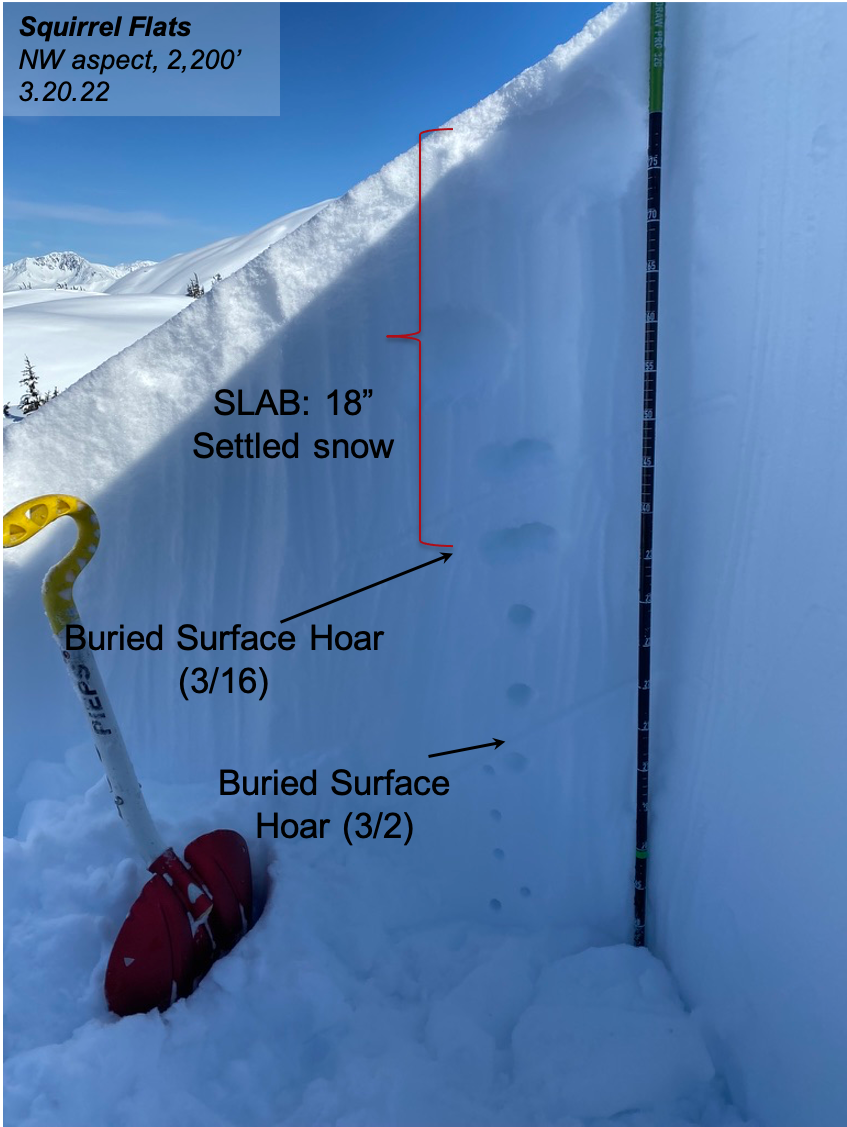A slow trickle of snowfall has been over the Eastern Turnagain Arm for the past 24 hours and that will continue today. So far, Turnagain Pass and Portage Valley have picked up around 5″ of new snow, while Girdwood Valley has seen 2-3″, and Summit Lake what looks to be just an inch. We are expecting another 2-5″ to fall during the daylight hours before the faucet really turns on with 2+ feet of snow from tonight through Friday morning…! Ridgetop winds have been easterly in the 10-20mph range with gusts in the 30’s, but these should also pick up today into the 30-40mph range. If these winds verify, it won’t take long for fresh wind slabs to build.
For today, it’s all about paying attention to changing conditions and watching for not only active wind loading creating fresh wind slabs, but remember there is some funny business 1-2′ deep in the snowpack; this is the buried surface hoar responsible for many human triggered avalanches a few days ago. If finding yourself in an area where over 6″ of new snow has piled up, watch for shallow storm slabs to be triggered. There was a new layer of surface hoar sprouting up during the weekend’s clear skies that is widespread from valley bottoms to ridgetops. This new surface hoar along with some near surface facets and some sun crusts on south aspects will all inhibit the new snow from bonding well. It’s critical that we keep in mind very touchy storm snow avalanche conditions will be likely with the onset of heavy snowfall.
 Photos are from John and Andrew’s Sunburst weather station mission on Monday (the station is back online!). 3.21.22.
Photos are from John and Andrew’s Sunburst weather station mission on Monday (the station is back online!). 3.21.22.
In addition to the avalanche concerns above, glide cracks may start to release. Glide cracks that are opening will become tough to see during the next few days as new snow and wind obscures them. With so many other avalanche issues and trending to a HIGH danger tomorrow, sticking to the lower angle slopes (30 degrees or less) with nothing above us will be recommended.
Some additional snowfall information from the NWS Recreation Forecast:
...2+ feet of snow expected by Friday morning. Snow levels
slowly rising to 500-1000 feet by Friday afternoon. Heaviest
period of precipitation Thursday afternoon through Friday morning.
 Graphic is provided courtesy of the NWS Anchorage Forecast Office. The weather models are showing significant snowfall for the interior Kenai, we’ll be watching to see if this is still on track tomorrow.
Graphic is provided courtesy of the NWS Anchorage Forecast Office. The weather models are showing significant snowfall for the interior Kenai, we’ll be watching to see if this is still on track tomorrow.

 Photos are from John and Andrew’s Sunburst weather station mission on Monday (the station is back online!). 3.21.22.
Photos are from John and Andrew’s Sunburst weather station mission on Monday (the station is back online!). 3.21.22. Graphic is provided courtesy of the NWS Anchorage Forecast Office. The weather models are showing significant snowfall for the interior Kenai, we’ll be watching to see if this is still on track tomorrow.
Graphic is provided courtesy of the NWS Anchorage Forecast Office. The weather models are showing significant snowfall for the interior Kenai, we’ll be watching to see if this is still on track tomorrow. Snow pit from the Placer Valley area at 2,200′. This pit had both layer of buried surface hoar with only the top layer (3/16) failing in stability tests. 3.20.22.
Snow pit from the Placer Valley area at 2,200′. This pit had both layer of buried surface hoar with only the top layer (3/16) failing in stability tests. 3.20.22.